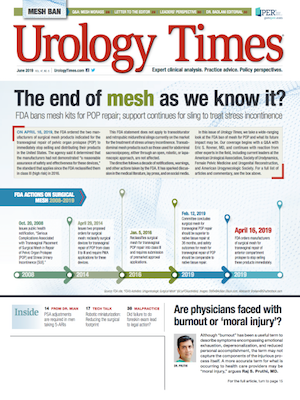Publication
Article
Urology Times Journal
AUA advocates for GME funding bill
Author(s):
In the face of President Trump’s proposed annual budget cuts of $47.9 billion for federal graduate medical education programs over the next decade, the medical profession is urging Congress to approve legislation to significantly increase federal GME support and help combat looming shortages in both primary and specialty care.
In the face of President Trump’s proposed annual budget cuts of $47.9 billion for federal graduate medical education (GME) programs over the next decade, the medical profession is urging Congress to approve legislation to significantly increase federal GME support and help combat looming shortages in both primary and specialty care.
In a May 3 letter to every member of Congress, a long list of organizations, including the AUA, urged lawmakers to co-sponsor “The Resident Physician Shortage Reduction Act of 2019.” That legislation would increase the number of residency positions eligible for Medicare direct graduate medical education and indirect medical education by 15,000 slots over the next 5 years.
In addition, the legislation directs that half of the newly available positions be slotted for training in shortage specialties such as urology; specifies priorities for distributing new slots, such as to states with new medical schools; and provides for studying the needs of the U.S. health care system to allocate residencies accordingly.
In the House of Representatives, the bill, H.R. 1763, was introduced by Reps. Terri Sewell (D-AL) and John Katko (R-NY). The Senate bill, S.348, was introduced by Sens. Robert Menendez (D-NJ), John Boozman (R-AR) and Charles Schumer (D-NY).
Funding formula would slash GME spending
The legislation comes in the face of a proposal contained in the Trump administration’s budget that would replace Medicare and Medicaid GME, as well as Children’s Hospital GME, with a single grant program funded out of the Treasury Department. Growth in funding would be capped at the sum of 2017 payments from the three programs adjusted for inflation, minus one percentage point annually. The new funding formula would slash program spending by $47.9 billion over 10 years.
In their letter to Congress, the medical organizations stressed that while the demand for physicians continues to grow faster than the supply, by 2030 there is expected to be a projected shortfall of between 42,600 and 121,300 physicians, both in primary and specialty care.
Also by Bob Gatty: ESWL reimbursement slashed by 22%
“If we do not address this impending problem, patients from pediatrics to geriatrics will find it difficult to access the care they need,” the letter warned. “While this is a serious issue for all of us, it is especially problematic because of our aging population and physician retirement. A person’s need for a physician increases with age, and the U.S. population aged 65 and older is predicted to grow 50% by 2030.”
For urology, the situation is especially serious, said AUA Public Policy Chair Christopher M. Gonzalez, MD, MBA.
“We know we have about 12,000 urologists in the country, and really only about 80% of those are actually practicing,” he said during the AUA’s Annual Urology Advocacy Summit in Washington. “So, really the question is where are they practicing and what is the geographic distribution? Digging deeper into the AUA Census, we find we have a maldistribution of doctors and urologists throughout the country. There’s a 9-1 ratio in urban areas versus rural areas. That’s a problem for us. You’ve got 50 million people in rural areas and not that many doctors.”
“Why is that important?” he asked. “Well, it’s important if you don’t have doctors in a county for urologic care, we know that the outcomes for cancer and the mortality from prostate, bladder, and kidney [cancers] are going to be a lot worse. So, it’s a real serious situation. We’re working with our politicians here in Washington, DC to see what we’re going to do about this.”
Thus, the AUA has joined with others in the medical community to urge support for the Resident Physician Shortage Reduction Act.
Next: Census points to work force concernsCensus points to work force concerns
According to the 2018 AUA Census, the number of urologists per capita has declined by more than 10% over the past 20 years. The median age of a urologist is 56 years, so many are approaching retirement. Complicating that situation is that training for urologists following medical school graduation is a minimum of 5 years and often longer.
According to the AUA Census, there are 12,660 practicing urologists, but only 10,696 (84.5%) are defined as “active.” As Dr. Gonzalez indicated, geographic distribution is a critical factor, with as many as 1,968 counties-or 62.6%-not having any urologists at all, while another 1,176 have only one urologist.
New Hampshire and New York state have the most urologists per 100,000 population, at 5.21 and 5.00 respectively, compared to a national average of 3.89. Meanwhile, Utah, North Dakota, Idaho, Wyoming, and Nevada have the fewest, all below three urologists per 100,000 population. Nevada is the worst in the nation at 2.40.
Read: Urologist advances in race for U.S. Congress
Some other key facts from the AUA’s 2018 Census that also indicate the urgency of taking action to increase support for medical education and to attract new physicians into the specialty include:
- The average number of work hours per week increased to 52.9 hours in 2018 from 51.6 hours in 2017.
- The median number of minutes a practicing urologist spends with a patient in a typical office visit is 15.
- Practicing urologists see 75 patients in a typical week, suggesting an estimated 3,600 patient visits/encounters per urologist during the year.
- The top reason urologists plan to retire before age 65 is a lack of time for personal and/or family life.
To increase their ability to serve patients in underserved areas, nearly 12% of practicing urologists in the U.S. participated in a telemedicine program in 2018. A vast majority, 83.3%, who participate in telemedicine expected those services to increase in 3 years.
A recent AUA Workforce and Compensation Survey indicated that up to 20% of currently practicing urologists intend to retire within the next 5 to 10 years, adding to the importance of ensuring a fully trained specialty physician work force for the future.


















